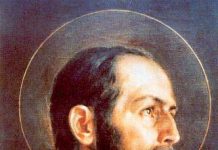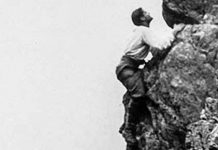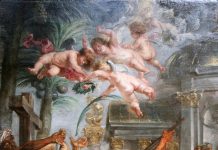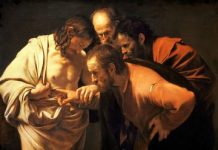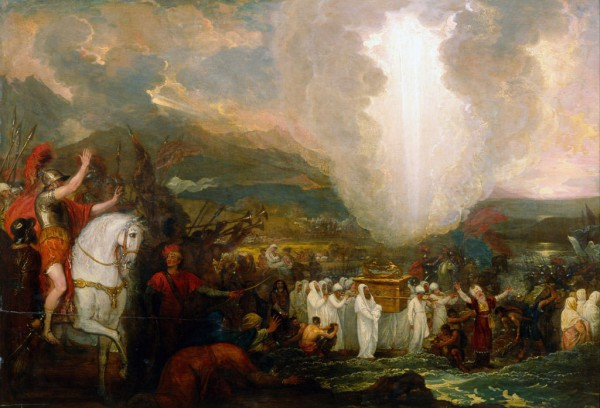
Perhaps you may be familiar with the Pillar of Cloud — which may be compared to a tornado — or the Pillar of Fire — which is a firenado — in the Old Testament, which accompanied and guided the Israelites as the former by day and as the latter by night,[1] or which accompanied the Tabernacle or the Ark of the Covenant wherever it went throughout the Old Testament.[2] Also called the Shekinah, the Pillar of Cloud or Fire was a manifestation of the presence of God and of His glory, was controlled through the mediating action of an Angel,[3] and served to guide[4] and to protect[5] the Ark of the Covenant, the Tabernacle, and the Israelites throughout their journey from Egypt, through the desert, and into the Promised Land.
What is interesting is that while most rightly reckon the Shekinah to be a type of the Holy Spirit, unknown to most is that the Shekinah is also a type of the Living Image of God the Father, the Most Glorious of the Old Testament Patriarchs, and the Patron of the Universal Church, Saint Joseph.[6] The reason that this typological relationship exists between the Shekinah and Joseph is due to their common function, and their common function is this: both the Shekinah and Joseph guided and protected their respective Arks of the Covenant or Tabernacles and their respective people.
As has been said above, it was the function of the Shekinah to guide and to protect the Ark of the Covenant or the Tabernacle and the people of God the Israelites. How does Saint Joseph fulfill this function if he does not guide nor protect neither the Ark of the Covenant nor the Tabernacle nor the Israelites? The answer is that Joseph does actually guide and protect the Ark of the Covenant, the Tabernacle and the people of God because he guides and protects the antitypes of the Ark of the Covenant, the Tabernacle and the people of God.
For the Ark of the Covenant and the Tabernacle are both types of Mary, the Living Ark of the Covenant and the Living Tabernacle.[7] This is because they possess the same contents inside of themselves; for the Tabernacle was the tent which contained the Ark of the Covenant,[8] and the Ark of the Covenant contained within itself three items,[9] viz., the Manna or “Bread from Heaven,”[10] the Tablet of the Decalogue or Ten Commandments,[11] and the Miraculous Rod of Aaron the High Priest of Israel.[12] Mary also possesses the same or similar contents inside of herself; for she is the Living Tabernacle because she possesses in herself Jesus Christ the Living Ark of the Covenant; Mary too also is the Living Ark of the Covenant because she possesses in herself Jesus Christ, Who is both the Living Manna, the Living “bread which comes down from heaven,”[13] and Who is the fulfillment of the Law and of the Prophets,[14] and Who is the Great High Priest.[15] Therefore, the Tabernacle and the Ark of the Covenant are types of Mary, since Mary possesses in herself all of the antitype contents by possessing in her womb Jesus, as the Tabernacle and the Ark of the Covenant possessed in themselves the Manna, the Decalogue, and the Rod of Aaron the High Priest of Israel.
Therefore, since Mary is the New Ark of the Covenant and the New Tabernacle of God, this makes sense why the Shekinah is a type of Saint Joseph. For Mary required a guide and a protector in order to guide her through the joys and sorrows of parenting the Son of God and to protect her from the malice of men and from other worldly dangers;[16] thus, Joseph would accompany Mary everywhere she went[17] — even when Mary went to visit her cousin Elizabeth at the Visitation, as the Tradition of the Church tells us through the Scholastic Theologians John Gerson and Isidore of Isolanis[18] — especially in her journey from Egypt, through the desert, and into the Promised Land,[19] just as the fiery Shekinah always accompanied the Ark of the Covenant wherever the Levites carried it in Israel’s journey from Egypt, through the desert, and into the Promised Land.
Therefore, the other side of the typology of the Shekinah and the Israelites also applies to Saint Joseph too, especially when one considers that Joseph is not only the Father of the Church,[20] but also the Patron of the Universal Church.[21] Since Joseph is the Father and Patron of the Catholic Church, Saint Joseph has a father’s duty to look out for all his spiritual children who make up the entire people of God in the Catholic Church. Therefore, just as Joseph protected and guided Mary the New Living Tabernacle and the New Living Ark of the Covenant as the imposing Shekinah protected and guided the Tabernacle and the Ark of the Covenant, so also does Saint Joseph protect and guide the people of God in the Catholic Church through his roles of Father of the Mystical Body of Christ and Patron of the Universal Church as the mighty Shekinah protected and guided the Israelites.
For just as it was in the presence of the Pillar of Fire that the Egyptians did not dare to harm or to even approach the chosen people of God the Israelites as they travelled from Egypt, through the desert, and into the Promised Land,[22] so also in the presence of Saint Joseph the Living Image of God the Father, the Patron of the Universal Church, and the Terror of Demons does no demon — including Satan himself — dare to harm or to even approach the People of God the Catholics as they journey from this world, through the desert of our earthly pilgrimage, and into the Promised Land of Heaven.
Endnotes:
[1] Exodus 13:21-22 (Revised Standard Version Catholic Edition), emphasis mine: “And the Lord went before them by day in a pillar of cloud to lead them along the way, and by night in a pillar of fire to give them light, that they might travel by day and by night; the pillar of cloud by day and the pillar of fire by night did not depart from before the people.”; Exodus 14:19-20 (Revised Standard Version Catholic Edition), emphasis mine: “Then the angel of God who went before the host of Israel moved and went behind them; and the pillar of cloud moved from before them and stood behind them, coming between the host of Egypt and the host of Israel. And there was the cloud and the darkness; and the night passed without one coming near the other all night.”
[2] Exodus 16:10; Exodus 19:16; Exodus 40:34; Exodus 40:36-38; Numbers 16:42.
[3] Exodus 14:19-20.
[4] Exodus 13:21-22; Exodus 40:36-38.
[5] Exodus 14:19-20.
[6] Edward Healy Thompson, M.A., The Life and Glories of Saint Joseph: Husband of Mary, Foster-Father of Jesus, and Patron of the Universal Church (Charlotte: TAN Books, 1888), 111: “That mysterious cloud which in the desert covered, as with a white veil, the Ark of the God of Israel, presents us with a striking figure of the office of Joseph, the most glorious of the Patriarchs, divinely elected to be the husband of Mary, the most highly gifted among all the daughters of Eve, in order to hide from every profane eye the adorable mystery which was to be effected in that true ark of the Living God, the bosom of Mary, wherein He was coming to abide as in His Tabernacle.”
[7] Thompson, The Life and Glories of Saint Joseph, 111.
[8] Hebrews 9:3-4 (Revised Standard Version Catholic Edition), emphasis mine: “Behind the second curtain stood a tent called the Holy of Holies, having the golden altar of incense and the ark of the covenant covered on all sides with gold, which contained a golden urn holding the manna, and Aaron’s rod that budded, and the tables of the covenant.”
[9] Hebrews 9:3-4 (Revised Standard Version Catholic Edition), emphasis mine: “Behind the second curtain stood a tent called the Holy of Holies, having the golden altar of incense and the ark of the covenant covered on all sides with gold, which contained a golden urn holding the manna, and Aaron’s rod that budded, and the tables of the covenant.”
[10] Exodus 16:31-34 (Revised Standard Version Catholic Edition), emphasis mine: “Now the house of Israel called its name manna; it was like coriander seed, white, and the taste of it was like wafers made with honey. And Moses said, ‘This is what the Lord has commanded: ‘Let an omer of it be kept throughout your generations, that they may see the bread with which I fed you in the wilderness, when I brought you out of the land of Egypt.’’ And Moses said to Aaron, ‘Take a jar, and put an omer of manna in it, and place it before the Lord, to be kept throughout your generations.’ As the Lord commanded Moses, so Aaron placed it before the testimony, to be kept.”
[11] Exodus 25:16 (Revised Standard Version Catholic Edition): “And you shall put into the ark the testimony [n.b., ‘the testimony’ is the Tablets of the Decalogue or the Ten Commandments] which I shall give you.”
[12] Numbers 17:1-11 (Revised Standard Version Catholic Edition), emphasis mine: “The Lord said to Moses, ‘Speak to the people of Israel, and get from them rods, one for each fathers’ house, from all their leaders according to their fathers’ houses, twelve rods. Write each man’s name upon his rod, and write Aaron’s name upon the rod of Levi. For there shall be one rod for the head of each fathers’ house. Then you shall deposit them in the tent of meeting before the testimony [i.e., before the Tablets of the Decalogue or the Ten Commandments], where I meet with you. And the rod of the man whom I choose shall sprout; thus I will make to cease from me the murmurings of the people of Israel, which they murmur against you.’ Moses spoke to the people of Israel; and all their leaders gave him rods, one for each leader, according to their fathers’ houses, twelve rods; and the rod of Aaron was among their rods. And Moses deposited the rods before the Lord in the tent of the testimony [i.e., in the Tabernacle]. And on the morrow Moses went into the tent of the testimony; and behold, the rod of Aaron for the house of Levi had sprouted and put forth buds, and produced blossoms, and it bore ripe almonds. Then Moses brought out all the rods from before the Lord to all the people of Israel; and they looked, and each man took his rod. And the Lord said to Moses, ‘Put back the rod of Aaron before the testimony, to be kept as a sign for the rebels, that you may make an end of their murmurings against me, lest they die.’ Thus did Moses; as the Lord commanded him, so he did.”
[13] John 6:50 (Revised Standard Version Catholic Edition).
[14] Matthew 5:17 (Revised Standard Version Catholic Edition): “Think not that I have come to abolish the law and the prophets; I have come not to abolish them but to fulfil them.”
[15] Hebrews 4:14 (Revised Standard Version Catholic Edition), emphasis mine: “Since then we have a great high priest who has passed through the heavens, Jesus, the Son of God, let us hold fast our confession.”
[16] Thompson, The Life and Glories of Saint Joseph, 111.
[17] Fr. Isidorus de Isolanis, O.P., Summa de Donis Sancti Ioseph (1522), Denuo Edita Berthier, (Rome: S.C. de Propaganda Fide, 1887), secunda pars, cap. vi (96-99).
[18] Thompson, The Life and Glories of Saint Joseph, 167-180; Joannes Gersonius, Sermo de Nativitate Gloriosae Virginis Mariae, Et de commendatione Virginei Sponsi ejus Joseph, tertia consideratio, in Opera Omnia Joannis Gersonii Doctoris Theologi & Cancellarii Parisienis (Antwerpia: Sumptibus Societatis, 1706), 1353; Fr. Isidorus de Isolanis, Summa de Donis Sancti Ioseph, secunda pars, cap. vi (96-99).
[19] Matthew 2:13-23.
[20] Leo XIII, Quamquam Pluries, Libreria Editrice Vaticana, August 15, 1889, https://www.vatican.va/content/leo-xiii/en/encyclicals/documents/hf_l-xiii_enc_15081889_quamquam-pluries.html, para. 3: “Atqui domus divina, quam Iosephus velut potestate patria gubernavit, initia exorientis Ecclesiae continebat. Virgo sanctissima quemadmodum Iesu Christi genitrix, ita omnium est christianorum, mater, quippe quos ad Calvariae montem inter supremos Redemptoris cruciatus generavit: itemque Iesus Christus tamquam primogenitus est christianorum, qui ei sunt adoptione ac redemptione fratres. — Quibus rebus caussa nascitur, cur beatissimus Patriarcha commendatam sibi peculiari quadam ratione sentiat multitudinem christianorum, ex quibus constat Ecclesia, scilicet innumerabilis isthaec perque omnes terras fusa familia, in quam, quia vir Mariae et pater est Iesu Christi, paterna propemodum auctoritate pollet. Est igitur consentaneum, et beato Iosepho apprime dignum, ut sicut ille olim Nazarethanam familiam, quibuscumque rebus usuvenit, sanctissime tueri consuevit, ita nunc patrocinio caelesti Ecclesiam Christi tegat ac defendat. [Now the divine house which Joseph ruled with the authority of a father, contained within its limits the scarce-born Church. From the same fact that the most holy Virgin is the mother of Jesus Christ is she the mother of all Christians whom she bore on Mount Calvary amid the supreme throes of the Redemption; Jesus Christ is, in a manner, the first-born of Christians, who by the adoption and Redemption are his brothers. And for such reasons the Blessed Patriarch looks upon the multitude of Christians who make up the Church as confided specially to his trust – this limitless family spread over the earth, over which, because he is the spouse of Mary and the Father of Jesus Christ he holds, as it were, a paternal authority. It is, then, natural and worthy that as the Blessed Joseph ministered to all the needs of the family at Nazareth and girt it about with his protection, he should now cover with the cloak of his heavenly patronage and defend the Church of Jesus Christ.]”
[21] Ibid., para. 3, emphasis mine: “[P]ropterea quod Iosephi cultum, quem superioribus quoque aetatibus romani Pontifices sensim provehere in maius et late propagare studuerant, postremo hoc tempore vidimus passim nec dubiis incrementis augescere, praesertim postea quam Pius IX fe. rec. decessor Noster sanctissimum Patriarcham [videlicet, Sanctum Joseph], plurimorum Episcoporum rogatu, patronum Ecclesiae catholicae declaravit…Cur beatus Iosephus nominatim habeatur Ecclesiae patronus. [We have seen the devotion to St. Joseph, which in past times the Roman Pontiffs have developed and gradually increased, grow into greater proportions in Our time, particularly after Pius IX., of happy memory, Our predecessor, proclaimed, yielding to the request of a large number of bishops, this holy patriarch [viz., Saint Joseph] the patron of the Catholic Church…The special motives for which St. Joseph has been proclaimed Patron of the Church.]”; Pius IX, Quemadmodum Deus, Oblates of St. Joseph: Holy Spouses Province, December 8, 1870, https://osjusa.org/st-joseph/magisterium/quemadmodum-deus/.
[22] Exodus 14:19-20 (Revised Standard Version Catholic Edition), emphasis mine: “Then the angel of God who went before the host of Israel moved and went behind them; and the pillar of cloud moved from before them and stood behind them, coming between the host of Egypt and the host of Israel. And there was the cloud and the darkness; and the night passed without one coming near the other all night.”

